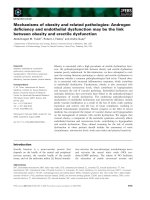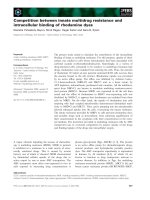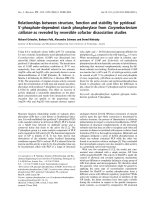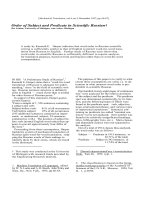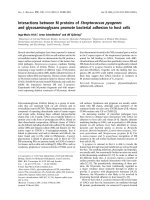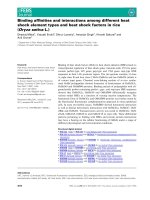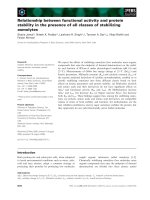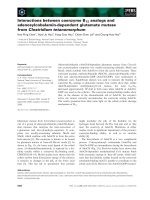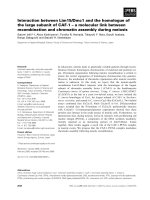Báo cáo khoa học: Interactions between metals and a-synuclein ) function or artefact? pptx
Bạn đang xem bản rút gọn của tài liệu. Xem và tải ngay bản đầy đủ của tài liệu tại đây (252.84 KB, 9 trang )
MINIREVIEW
Interactions between metals and a-synuclein
)
function or
artefact?
David R. Brown
Department of Biology and Biochemistry, University of Bath, UK
Introduction
Advances in research in recent years have linked
many neurodegenerative diseases to specific proteins
that undergo either abnormal conformational changes
or whose metabolism is somehow modified. Links
between Alzheimer’s disease (AD) and amyloid-b
(Ab) Creutzfeldt–Jakob disease and prions are well
documented [1]. In recent years, another protein has
been discovered that is related to a variety of neuro-
degenerative disorders. This protein, originally termed
the nonamyloid component precursor, was identified
in the plaques of AD and was later termed a-synuc-
lein [2]. Altered forms of a-synuclein are also found
in the deposits termed Lewy bodies (LBs) [3] (Fig. 1).
a-synuclein desposits are associated with diseases such
as Parkinson’s disease (PD), multiple system atrophy
and sporadic and inherited LB diseases. PD is the
most common neurodegenerative disorder after AD.
LBs can also be identified in some cases of AD.
Therefore changes in this protein are associated with
the most common neurodegenerative diseases, inclu-
ding AD. Due to its recent discovery, research into
the causal relation between a-synuclein and these dis-
eases remains in its early beginnings. Much of the
research related to this protein has been to identify
mutations associated with disease [4,5], create an
animal model [6] or to understand the mechanism by
which the protein aggregates [7]. The function of
the protein remains unknown. However, results from
knockout mice suggest that it plays an important role
in dopaminergic neurones, possibly regulating the
release of dopamine from presynaptic termini. Over-
expression of a-synuclein results in death of dopamin-
ergic neurones of the substantia nigra, further
emphasizing the importance of normal regulation of
this protein to this cell type [8].
PD is a severe, progressive motor disorder caused by
changes in the central nervous system (CNS). True PD
is tightly linked to degeneration of neurones in an area
of the ventral midbrain or basal ganglia known as the
substantia nigra pars compacta. The neurones affected
Keywords
amyloid; copper; Lewy body; Parkinson’s
disease
Correspondence
D. R. Brown, Department of Biology and
Biochemistry, University of Bath,
Claverton Down, Bath BA2 7AY, UK
Fax: +44 1225 386779
Tel: +44 1225 383133
E-mail:
(Received 9 March 2007, revised 1 May
2007, accepted 7 May 2007)
doi:10.1111/j.1742-4658.2007.05917.x
a-synuclein is one of a family of proteins whose function remains
unknown. This protein has become linked to a number of neurodegenera-
tive disease although its potential causative role in these diseases remains
mysterious. In diseases such as Parkinson’s disease and Lewy body demen-
tias, a-synuclein becomes deposited in aggregates termed Lewy bodies.
Also, some inherited forms of Parkinson’s diseases are linked to mutations
in the gene for a-synuclein. Studies have mostly focussed on what causes
the aggregation of the protein but, like many amyloidogenic proteins asso-
ciated with a neurodegenerative disorder, this protein has now been sugges-
ted to bind copper. This finding is currently controversial. This review
examines the evidence that a-synuclein is a copper binding protein and dis-
cusses whether this has any significance in determining the function of the
protein or whether copper binding is at all necessary for aggregation.
Abbreviations
Ab, amyloid-b; AD, Alzheimer’s disease; CNS, central nervous system; DLB, dementia with LB; LB, Lewy body; MPTP, 1-methyl-4-phenyl-
1,2,3,6-tetrahydropyrodine; NAC, nonamyloid-b component; PD, Parkinson’s disease.
3766 FEBS Journal 274 (2007) 3766–3774 ª 2007 The Author Journal compilation ª 2007 FEBS
are specifically ones that generate the compound dop-
amine as a neurotransmitter and are termed dopamin-
ergic neurones. The disease was first described in 1817
by James Parkinson and was also termed shaky palsy
because of the shaking movement made by the patients.
The disease effects approximately 1 in every 500 people.
Other diseases with similar symptoms are often des-
cribed as ‘parkinsonian’ because of the symptoms
exhibited. One such disease is manganism. However,
these diseases must be separated from true PD which
is specifically a disease result from degeneration of
dopaminergic neurones in the substantia nigra.
Approximately 50–70% of all the dopaminergic neu-
rones are lost from this region before symptoms of the
disease appear [9]. Like most neurodegenerative disor-
ders, the true cause of the diseases remains uncertain.
There is strong evidence that familial or inherited
forms are linked to particular point mutations in cer-
tain genes such as a-synuclein or parkin. A common
treatment of the disorder is to supply l-3,4-dihydroxy-
phenylalanine, a precursor molecule for the lost neuro-
transmitter.
The clinical symptoms of PD include resting trem-
ors, muscle rigidity and bradykinesia. As well as exten-
sive dopaminergic neuronal loss the presence of LBs,
containing a-synuclein fibrils, in the substantia nigra
and other brain regions are characteristic of the disease
[10,11]. Inclusions containing a-synuclein are also
found in dementia with LBs (DLB), multiple system
atrophy and the ‘Lewy body variant’ of AD [12]. It is
likely that a-synuclein plays a critical role in the patho-
genesis of these diseases because rare missense muta-
tions in the SNCA gene (resulting in amino acid
substitutions A30P, E46K, A53T) or duplication or
triplication of the a-synuclein locus have been
linked to familial forms of either PD [13–17] or DLB
[15]. Furthermore, transgenic animals overexpressing
wild-type or mutant human a-synuclein develop clin-
ical and pathological features very similar to those
observed in PD [18,19], suggesting that the accumula-
tion of aggregated forms of a-synuclein in the brain
could be the underlying cause of neurodegeneration in
PD and related disorders.
Most patients with PD have a sporadic form that
has not been possible to link to mutations in any
known gene. Approximately 15% of patients claim to
have a family member who also had the disease [20].
Huge numbers of genetic linkage studies have been
undertaken to attempt to find the gene associated with
PD in the inherited forms. Paradoxically, there has
been no single gene identified as the PD gene. Muta-
tions in a large number of proteins have been found.
The genetic loci associated with PD have been given
the designation PARK. The first of these to be identi-
fied was PARK-1 which is associated with the protein
a-synuclein and is found on human chromosome 4q21
[13]. In this case, the disease either arises through
missense point mutations (A53T, A30P or E46K) or
through triplication of the gene. The latter demon-
strates that simple increased expression of a-syncuclein
could be sufficient to cause disease. These mutations
are associate with early onset of the disease and has
the pathology includes LBs and is autosomal domin-
ant [21].
a-synuclein
a-synuclein is a small (14 kDa), highly conserved,
presynaptic protein of unknown function, expressed
highly in specific brain regions [22–25]. It belongs to a
family of proteins including b-synuclein and c-synuc-
lein [3]. In contrast to a-synuclein, these two proteins
do not appear to aggregate or form fibrils [26]. How-
ever, b-synuclein is known to inhibit a-synuclein aggre-
gation and the relative levels of the two proteins may
be a significant fucator is the occurance of a-synuclein
related pathology [27].
a-synuclein has a series of imperfect repeats
(KTKEGV) at the N-terminus, as well as an acid
C-terminal domain (amino acid residues 96–140) and
appear from recombinant studies, to be a natively
unfolded protein [23,28–31]. In addition, like most
natively unfolded proteins, it has low overall hydro-
phobicity and a large net negative charge [32]. a-synuc-
leins show 55–62% identity to b- and c-synuclein [3].
a- and b-synuclein have identical N-termini and both
these proteins are concentrated in nerve terminals in
the proximity of synatpic vesicles [33]. c-synuclein
is expressed throughout nerve terminals. a-synuclein
Fig. 1. A transverse section of the substantia nigra from a PD
patient showing two LBs. These deposits are composed largely of
a-synuclein.
D. R. Brown Interactions between metals and a-synuclein
FEBS Journal 274 (2007) 3766–3774 ª 2007 The Author Journal compilation ª 2007 FEBS 3767
became of interest to the study of neurodegenerative
diseases after the discovery of the nature of what was
then termed the ‘nonAb component’ (NAC) of plaques
in AD [34,35]. The protein then termed NAC-precur-
sor or phosphoneuroprotein-14 turned out to be a
homologue of synuclein originally identified in the elec-
tric organ of the Pacific electric ray (Torpedo californi-
ca) [10]. Subsequenty, there has been no conformation
of a role of NAC in AD but a-synuclein is now accep-
ted as the main component of LBs as found in PD
and LB dementias [Fig. 2]. a-synuclein can also be
found as small oligomers or smaller aggregates associ-
ated with synapses and it is possible these forms con-
tribute to the disease process rather than LBs [36].
a-synuclein can bind to lipids membranes through
its N-terminal repeat region [37] and can selectively
inhibit phospholipase-D2 [31]. This phospholipase is
localized to the cell membrane where it is involved in
signal-induced cytoskeleton regulation and endocytosis.
It is therefore possible that alpa-synculein regulates
vesicular transport processes. a-synuclein appears to be
phosphorylated [38] and this may have some conse-
quences for the protein’s function. There is some evi-
dence that the protein interacts with synphilin-1 [39],
another protein of unknown function, and this protein
has also been identified in LBs [40].
Knockout mice have been generated that do not
express a-synuclein. These mice do not show any
neuropathological changes, suggesting that loss of
function of the protein does not play a direct role in
any form of cell death [41]. However, loss of the pro-
tein does result in abnormal activity of dopaminergic
neurones in substantia nigra, with reduced levels of
dopamine detected in the striatum. This implies that
the protein could play a role in the regulation of
neutransmitter release. A second strain of a-synuclein
knockout mice was also developed [42]. Certain toxins
will induce parkinsonian changes in mice. One such
compound 1-methyl-4-phenyl-1,2,3,6-tetrahydropyro-
dine (MPTP) induced degeneration and loss of dopam-
inergic neurones. This second line of knockout mice
proved resistant to the effect of MPTP. MPP+, the
metabolic product of MPTP, acts on various elements
of the synaptic machine. Again, these results suggest a
role for a-synuclein in vesicular function. Recently, a
double knockout mouse has been generated lacking
both a- and b-synuclein [43]. Again dopamine levels
were found to be reduced in the brain but studies of
neurones isolated in culture found no differences to
wild-type mice. This suggests that synucleins are not
essential components of the machinery that causes neu-
rotransmitter release, but they may contribute to long-
term regulation of presynaptic activities. Given the
similarity between the synuclein, possibly a triple
knockout mouse is necessary to understand the func-
tion of these proteins in the CNS. It is more likely,
however, that the role played by a-synuclein in disease
results from dysfunction due to its aggregation.
There have been more than ten groups that have
generated a-synuclein transgenic mice [18,44–52]. The
mice either expressed human wild-type a-synuclein or
the human protein carrying one of the two main
mutants (A53T or A30P). These mice differ in the level
of expression of the protein and in the kind of promo-
ter used to generate expression. Promoters used
include those for platelet-derived growth factor-b,
Thy-1, prion protein, tyrosine hydoxylase or an oligo-
dendrocyte specific promoter. The results from these
many experiments were quite variable. However, many
of the mice produced accumulations of a-synuclein
and showed changes in the dopaminergic system. In
addition, many of the mice showed motor changes
reminiscent of the parkinsonian tremor or altered loco-
motion or coordination. However, none of the mice
showed neuronal loss, no matter how high the expres-
sion level or the presence of mutations. Expression
within glial cells resulted in inclusions with a greater
similarity to LBs. The failure of transgenic mice to
result in a reliable model of PD is possibly due to the
expression of a human protein in a mouse. Co-expres-
sion of mouse and human a-synuclein could alter the
ability of the human protein to form a toxic molecule,
Fig. 2. Cell inclusions: overexpression of a-synuclein in cells results
in aggregation of a-synuclein within the cells. This SH-SY5Y over-
expressing a-synuclein was immunostained for a-synuclein. In
approximately 10% of cases, these aggregates form on a large single
aggregate resembling an LB. Image supplied by Josephine Wright.
Interactions between metals and a-synuclein D. R. Brown
3768 FEBS Journal 274 (2007) 3766–3774 ª 2007 The Author Journal compilation ª 2007 FEBS
as it is known that mixing human and mouse a-synuc-
lein inhibits the ability of the protein to aggregate [53].
Therefore, the animal models based on neurotoxins
such as MPTP and rotenone are more reliable and
reproduce the disease more effectively than transgenic
mice. Unfortunately, such models do not provide
insight into how changes in a-synuclein cause disease
as the disease is generated by another source.
Recently, a viral vector system was used to directly
transfer the human a-synuclein into the substantia nigra
of a rat [54]. The recombinant adeno-associated viral
vector resulted in high expression of the human protein
in the substantia nigra and, after 13 weeks, the research-
ers observed a 50% reduction in the number of dopam-
inergic neurones. Unlike other models, the progression
of cell loss was slower, more like PD. In addition, there
were other changes that were more similar to the human
disease, including phosphorylation of a-synuclein at
serine 129 and activation of caspase 9. This system
possibly represents a better model of PD.
Metal binding
The study of a-synuclein function has been hampered
by a lack of phenotype in knockout mice and the
inconclusive nature of studies from cell biology and bio-
chemistry. Although studies do suggest that a-synuclein
expression can influence a variety of cellular activities
such as vesicle trafficking, no study has clearly shown
that the protein is essential for anything. Although it
might be easy to conclude that the protein has no func-
tion, it is rather nonsensical to do so because the protein
is evolutionarily conserved and has homologues such as
b-synuclein.
One of the simplest recourses for studies of function
is to associate the protein with particular cofactors
that are commonly used for a variety of biological
activities. With the suggestion that a-synuclein binds
copper, we have the potential to link the protein into
copper metabolism or activities associated with copper
binding proteins.
Initial evidence for the potential of a-synuclein to
bind metals came from the ability of certain metals
catalyse aggregation of the protein (see below). It was
suggested the protein could bind up to ten atoms of
copper with a low affinity value of 59 lm [55]. Analy-
sis of the potential binding site indicated that aggrega-
tion of the protein was only initiated if the C-terminus
was intact [56]. This suggested that the C-terminus was
the principal binding site for Cu (Fig. 3). Despite early
studies suggesting the Cu causes aggregation of the
protein via the C-terminus, a more recent study sug-
gests that Cu binds to the histidine at residue 50 in the
N-terminus with higher affinity [56]. Binding at the
high affinity site was shown to be sufficient to drive
oligomerization of the protein. The high affinity site
appeared to be a type-II copper binding site with
square planar co-ordination. However, the affinity for
this site is suggested to bind Cu at 0.1 lm. That for
the second site was shown to bind Cu at 50 lm, which
is in line with previous findings [55,57]. However, these
affinities seem rather low for an intracellular protein
where Cu would be bound by proteins with a much
higher affinity. Under such conditions, it is likely that
these other proteins would out-compete a-synuclein for
Cu. The C-terminus of the protein has also been sug-
gested to bind polyamines [58]. These polyamines can
also initiate aggregation of the protein. Different
papers suggest Cu initiates aggregation at the C- and
N-terminal copper binding sites. These conflicting
reports and the weak affinity constants mean that whe-
ther Cu binds or not and where is uncertain. It is poss-
ible that the weak affinity measures simply reflect
deficiencies in the experimental design but, clearly, fur-
ther investigation is necessary.
Despite these deficiencies, further research on Cu
binding has continued. The results from some more
recent papers are as intriguing as they are confusing.
Although a previous study [56] suggested that only the
histidine at position 50 was necessary for Cu binding,
a more recent study suggested that Cu binding requires
nine N-terminal amino acid residues in addition to
amphipathic region
Seven II-mer repeats
NAC
7
89
140
57
52
9
1
residues
α
α
-140
A30P
A53T
E43K
High affinity Cu Site
Low affinit
y
Cu Site
65
4
231
acidic tail
(capable of forming 5 α-helixes)
Fig. 3. Linear representation of the a-synuc-
lein protein. The location of the repeats in
the N-terminus, the NAC domain thought to
be involved in aggregation and the proposed
Cu binding domains are shown. Also shown
are the locations of the three mutations
associated with inherited froms of PD.
D. R. Brown Interactions between metals and a-synuclein
FEBS Journal 274 (2007) 3766–3774 ª 2007 The Author Journal compilation ª 2007 FEBS 3769
residues 48–52 [59]. Furthermore, it was suggested that
the C-terminal site (residues 191–124) binds other
metals (such as Mn or Fe) with a very low (mm) affin-
ity. Such low affinities should really be considered as
nonspecific associations and do not provide convincing
evidence for a-synclein being a metal binding protein.
In a further NMR study, a-synuclein was suggested to
have as many as 16 different amino acid residues that
could participate in Cu binding [60]. Deletion of H50
from the protein did little to abolish Cu binding and
clearly showed that this histidine may participate in
Cu binding but is not critical. Although proposing
additional C- and N-terminal binding sites, the study
did not provide conclusive evidence for a high affinity
Cu site but suggested that a loose association between
many amino acids resides and Cu was possible. As a
variety of amino acids can bind Cu in solution, this
result is neither surprising, nor convincing.
Two further studies with peptide fragments of the
N-terminus have been published. These studies are lar-
gely based on potentiometric techniques augmented
with circular dicroism and electron paramagnetic reso-
nance spectroscopies. They showed that aspartate in
the first 17 amino acid residues plays an important role
in the co-ordination of Cu [61]. This interaction can
also result in the oxidation of methionine residues [62].
However, using similar techniques, the same group
showed that Cu is co-ordinated with a peptide with
residues 39–56 and that both the histidine and lysine res-
idues are involved in the co-ordination [63]. Although
these studies provide interesting insights into the
co-ordination of Cu by these fragments, they do not
provide any more convincing evidence that these
Cu–peptide interactions are specific and would occur
in vivo. Additionally, Cu-peptide studies are notori-
ously misleading because Cu co-ordination changes
with large fragments and it is possible that full length
a-synuclein would bind Cu in a completely different
way to these artificial peptides.
Although the summation of these various studies
points clearly towards a future for a-synuclein as a
metalloprotein, the evidence necessary to make the
story convincing remains undiscovered. Further studies
carried out under physiological conditions could
potentially provide the missing element needed to
demonstrate that Cu binding to a-synuclein is not an
artefact.
a-synuclein aggregation
Cells expressing high levels of a-synuclein have been
shown to generate aggregates of protein [64] (Fig. 2).
It remains unclear as to why this occurs and what the
mechanism is behind the process. It is also unclear
whether this process is really causal to neurodegenera-
tive disease. The formation of LBs or other aggregates
of this protein might be a result of the disease rather
than the cause. However, as inherited mutations in the
protein are associated with PD, it is likely that the pro-
tein plays some role in the progression of the disease.
Both peptides and recombinant protein have been
used to study the aggregation properties of a-synuc-
lein. Filaments will form from the N-terminal domain
of the protein with similar properties the protein
aggregates extracted from the brains of Parkinson
patients [4,65–68]. The kinetics of fibrillation are con-
sistent with a nucleation mechanism [69,70]. The key
step in the transformation of the protein to a form
able to aggregate involves a partially folded interme-
diate [64]. The final transition of the protein results
in a gain of b-sheet content. The fibrils that are
formed are amyloid-like, around 5–10 nm in length
with a diameter of 4–8 nm (Fig. 4). These can cluster
together to form bundles of 50 nm and up to 1 mm
in length [2,66,71]. Peptides from amino acid resi-
dues 1–18 behaved similarly to the full length protein,
suggesting that this domain is key to the aggregation.
In comparison, a peptide based on amino acid resi-
dues 19–35 remained soluble and unstructured [72].
Further analysis suggested that the residues 8–16 are
key to the formation of b-sheet. These findings are in
contrast to another study suggesting that the main
site regulating protein aggregation is around amino
acid residues 64–100 [73]. Small peptides from this
region (residues 69–72) have been shown to block
aggregation of the full-length a-synuclein [73]. It is
possible that both these regions add to the fibril for-
mation of the protein.
Fig. 4. a-synuclein can aggregate to form fibrils. Electron micro-
scopic analysis of purified a-synuclein fibrils shadow stained with
phosphotungstic acid. a-synuclein forms long filamentous struc-
tures when it aggregates under specific conditions and such fil-
ments can also be extracted from LBs.
Interactions between metals and a-synuclein D. R. Brown
3770 FEBS Journal 274 (2007) 3766–3774 ª 2007 The Author Journal compilation ª 2007 FEBS
Of greater interest is the assessment of factors that
could contribute to the aggregation of the protein.
Phosphorylation of serine 129 increases fibril formation
[74]. Sequence modification is the most obvious cause
of increased aggregation and mutations associated with
pathology in particular [75]. In addition, oxidation and
nitration can also increase the rate of conversion [76].
Binding of polyanions to the C-terminal domain can
also catalyse protein aggregation [58].
Current research has suggested that one of the main
factors affecting self-oligomerization of the protein
is the presence of metals, such as Cu. Cu has been sug-
gested to be the most effective metal in terms of inducing
oligomerization [55]. Cu chelators were shown to
abolish aggregation. This oligomerization seemed to be
mediated by interaction of Cu with the C-terminus of
the protein. This was shown by limited proteolysis of
the a-synuclein that cleaved off part of the C-terminus,
either at residue 97 or 114. The shorter fragment showed
no response to Cu in terms of oligomerization, whereas
the 1–114 fragment did produce a limited amount of
oligomerization [57]. Further studies showed that metals
not only induce aggregation, but also induce conforma-
tional change. Aluminium was found to be the most
effective metal at induction of polymerization with Cu
and Fe being similarly effective [30]. Analysis suggested
that the mechanism of polymerization could either lead
to amorphous aggregates or structured fibrils. Structural
analyses also showed that the metals induced a switch
from unstructured to a b-sheet structure.
The concentration of metals necessary to produce
a-synuclein aggregation is quite controversial. In
general, concentrations of metals shown to cause
aggregation or fibril formation of a-synuclein are well
above physiological values. In other words, the con-
centrations would be toxic on their own. Although one
study [56] has suggested that as little as 40 lm can
initiate a-synuclein aggregation, this has not been dem-
onstrated in others [56,65]. Also, this concentration is
higher than the concentration of the ‘high’ affinity
binding site reported by the same authors [56]. There-
fore, it is unclear whether metal induced aggregation
results from specific binding of a metal or a nonspecific
association. If the latter is the case, then it is quite
possible that the metals themselves are unnecessary for
the process and all that is really required is oxidation,
as suggested by other studies [77].
Conclusions
There is no doubt that a-synuclein is associated with
neurodegenerative disease. The fact that mutants of
a-synuclein are associated with inherited forms of PD
provides clear evidence for this. However, the mechan-
ism or role of the protein remains elusive. Is aggrega-
tion important for its effect or just high levels of
expression? Similarly, aggregates of a-synuclein in the
form of LBs are associated with CNS disease, but is
aggregation really caused by binding of particular metal
ions? The very high concentrations of metals that have
been shown to effective in vitro do not really support
this. Perhaps oxidative modification of the protein is
more likely to be the cause of the aggregation and metal
ions, such as Cu or Fe, can catalyse Fenton chemistry
that would generate the oxidative species necessary.
Finally, is a-synuclein really a copper binding protein
under physiological conditions? The low affinities cur-
rently reported do not really support this, and there is
no real evidence available to support a functional role
of a-synuclein as a metalloprotein. The true situation is
that there is insufficient evidence available to conclude
one way or the other whether metal binding to a-synuc-
lein is an artefact or not. However, the new evidence
suggesting that a-synuclein is a metal binding protein
is intriguing and is likely to result in a robust, new
research direction in the synuclein field.
References
1 Prusiner SB (1982) Novel proteinaceous infectious parti-
cles cause scrapie. Science 216, 136–144.
2 Iwai A, Masliah E, Yoshimoto M, Ge N, Flanagan L,
de Silva HA, Kittel A & Saitoh T (1995) The precursor
protein of non-A beta component of Alzheimer’s disease
amyloid is a presynaptic protein of the central nervous
system. Neuron 14, 467–475.
3 Goedert M (2001) Alpha-synuclein and neurodegenera-
tive diseases. Nat Rev Neurosci 2, 492–501.
4 Conway KA, Harper JD & Lansbury PT (1998) Accel-
erated in vitro fibril formation by a mutant alpha-synuc-
lein linked to early-onset Parkinson disease. Nat Med 4,
1318–1320.
5 Zarranz JJ, Alegre J, Gomez-Esteban JC, Lezcano E,
Ros R, Ampuero I, Vidal L, Hoenicka J, Rodriguez O,
Atares B et al. (2004) The new mutation, E46K, of
alpha-synuclein causes Parkinson and Lewy body
dementia. Ann Neurol 55, 164–173.
6 Fernagut P-O & Chesselet M-F (2004) Alpha-synuclein
and transgenic mouse models. Neurobiol Dis 17,
123–130.
7 Goldberg MS & Lansbury PT Jr (2000) Is there a
cause-and-effect relationship between alpha-synuclein
fibrillization and Parkinson’s disease? Nat Cell Biol 2,
E115–E119.
8 Brazilai A & Melamed E (2003) Molecular mechanisms
of selective dopaminergic neuronal death in Parkinson’s
disease. Trends Mol Med 9, 126–132.
D. R. Brown Interactions between metals and a-synuclein
FEBS Journal 274 (2007) 3766–3774 ª 2007 The Author Journal compilation ª 2007 FEBS 3771
9 Xu J, Kao SY, Lee FJ, Song W, Jin LW & Yankner
BA (2002) Dopamine-dependent neurotoxicity of alpha-
synuclein: a mechanism for selective neurodegeneration
in Parkinson disease. Nat Med 8, 600–606.
10 Spillantini MG, Goedert M, Crowther RA, Murrell JR,
Farlow MR & Ghetti B (1997) Alpha-synuclein in Lewy
bodies. Nature 388, 839–841.
11 Arima K, Ueda K, Sunohara N, Hirai S, Izumiyama Y,
Tonozuka-Uehara H & Kawai M (1998) Immunoelec-
tronmicroscopic demonstration of NACP ⁄ alpha-synuc-
lein epitopes on the filamentous component of Lewy
bodies in Parkinson’s disease and in dementia with
Lewy bodies. Brain Res 808, 93–102.
12 Bennett MC (2005) The role of alpha-synuclein in neu-
rodegenerative diseases. Pharmacol Ther 105, 311–331.
13 Polymeropoulos MH, Lavedan C, Leroy E, Ide SE,
Dehejia A, Dutra A, Pike B, Root H, Rubenstein J,
Boyer R et al. (1997) Mutation in the alpha-synuclein
gene identified in families with Parkinson’s disease.
Science 276, 2045–2047.
14 Kru
¨
ger R, Kuhn W, Muller T, Woitalla D, Graeber M,
Kosel S, Przuntek H, Epplen JT, Schols L & Riess O
(1998) Ala30Pro mutation in the gene encoding alpha-
synuclein in Parkinson’s disease. Nat Genet 18, 106–108.
15 Greenbaum EA, Graves CL, Mishizen-Eberz AJ, Lupoli
MA, Lynch DR, Englander SW, Axelsen PH & Giasson
BI (2005) The E46K mutation in alpha-synuclein increa-
ses amyloid fibril formation. J Biol Chem 280, 7800–
7807.
16 Singleton AB, Farrer M, Johnson J, Singleton A, Hague
S, Kachergus J, Hulihan M, Peuralinna T, Dutra A,
Nussbaum R et al. (2003) Alpha-synuclein locus tripli-
cation causes Parkinson’s disease. Science 302, 841.
17 Chartier-Harlin MC, Kachergus J, Roumier C, Mou-
roux V, Douay X, Lincoln S, Levecque C, Larvor L,
Andrieux J, Hulihan M et al. (2004) Alpha-synuclein
locus duplication as a cause of familial Parkinson’s dis-
ease. Lancet 364, 1167–1169.
18 Masliah E, Rockenstein E, Veinbergs I, Mallory M,
Hashimoto M, Takeda A, Sagara Y, Sisk A & Mucke L
(2000) Dopaminergic loss and inclusion body formation
in alpha-synuclein mice: implications for neurodegenera-
tive disorders. Science 287, 1265–1269.
19 Feany MB & Bender WWA (2000) A Drosophila model
of Parkinson’s disease. Nature 404, 394–397.
20 Huang Y, Cheung L, Rowe D & Halliday G (2004)
Genetic contributions to Parkinson’s disease. Brain Res
Brain Res Rev 46, 44–70.
21 Vila M & Przedborski S (2004) Genetic clues to the
pathogenesis of Parkinson’s disease. Nat Med 10 (Suppl. ),
S58–S62.
22 Maroteaux L, Campanelli JT & Scheller RH (1988)
Synuclein: a neuron-specific protein localized to the nuc-
leus and presynaptic nerve terminal. J Neurosci 8,
2804–2815.
23 Jakes R, Spillantini MG & Goedert M (1994) Identifica-
tion of two distinct synucleins from human brain. FEBS
Lett 345, 27–32.
24 Langston JW, Sastry S, Chan P, Forno LS, Bolin LM
& Di Monte DA (1998) Novel alpha-synuclein-immuno-
reactive proteins in brain samples from the Contursi
kindred, Parkinson’s, and Alzheimer’s disease. Exp
Neurol 154, 684–690.
25 George JM, Jin H, Woods WS & Clayton DF (1995)
Characterization of a novel protein regulated during the
critical period for song learning in the zebra finch.
Neuron 15, 361–372.
26 Biere AL, Wood SJ, Wypych J, Steavenson S, Jiang Y,
Anafi D, Jacobsen FW, Jarosinski MA, Wu GM,
Louis JC et al. (2000) Parkinson’s disease-associated
alpha-synuclein is more fibrillogenic than beta- and
gamma-synuclein and cannot cross-seed its homologs.
J Biol Chem 275, 34574–34579.
27 Hashimoto M, Rockenstein E, Mante M, Mallory M &
Masliah E (2001) Beta-synuclein inhibits alpha-synuclein
aggregation: a possible role as an anti-parkinsonian
factor. Neuron 32, 213–223.
28 Goedert M (1997) Familial Parkinson’s disease. The
awakening of alpha-synuclein. Nature 388, 232–233.
29 Weinreb PH, Zhen W, Poon AW, Conway KA &
Lansbury PT Jr (1996) NACP, a protein implicated in
Alzheimer’s disease and learning, is natively unfolded.
Biochemistry 35, 13709–13715.
30 Uversky VN, Li J & Fink AL (2001) Evidence for a
partially folded intermediate in alpha-synuclein fibril
formation. J Biol Chem 276, 10737–10744.
31 Eliezer D, Kutluay E, Bussell R Jr & Browne G
(2001) Conformational properties of alpha-synuclein in
its free and lipid-associated states. J Mol Biol 307,
1061–1073.
32 Uversky VN, Gillespie JR & Fink AL (2000) Why are
‘natively unfolded’ proteins unstructured under physio-
logic conditions? Proteins 41, 415–427.
33 Clayton DF & George JM (1999) Synucleins in synaptic
plasticity and neurodegenerative disorders. J Neurosci
Res 58, 120–129.
34 Tobe T, Nakajo S, Tanaka A, Mitoya A, Omata K,
Nakaya K, Tomita M & Nakamura Y (1992) Cloning
and characterization of the cDNA encoding a novel
brain-specific 14-kDa protein. J Neurochem 59,
1624–1629.
35 Ueda K, Fukushima H, Masliah E, Xia Y, Iwai A,
Yoshimoto M, Otero DA, Kondo J, Ihara Y & Saitoh
T (1993) Molecular cloning of cDNA encoding an
unrecognized component of amyloid in Alzheimer
disease. Proc Natl Acad Sci USA 90, 11282–11286.
36 Kramer ML & Schulz-Schaeffer WJ (2007) Presynaptic
alpha-synuclein aggregates, not Lewy bodies, cause neu-
rodegeneration in dementia with Lewy bodies. J Neuro-
sci 27, 1405–1410.
Interactions between metals and a-synuclein D. R. Brown
3772 FEBS Journal 274 (2007) 3766–3774 ª 2007 The Author Journal compilation ª 2007 FEBS
37 Davidson WS, Jonas A, Clayton DF & George JM
(1998) Stabilization of alpha-synuclein secondary struc-
ture upon binding to synthetic membranes. J Biol Chem
273, 9443–9449.
38 Pronin AN, Morris AJ, Surguchov A & Benovic JL
(2000) Synucleins are a novel class of substrates for G
protein-coupled receptor kinases. J Biol Chem 275,
26515–22622.
39 Engelender S, Kaminsky Z, Guo X, Sharp AH, Amar-
avi RK, Kleiderlein JJ, Margolis RL, Troncoso JC,
Lanahan AA, Worley PF et al. (1999) Synphilin-1 asso-
ciates with alpha-synuclein and promotes the formation
of cytosolic inclusions. Nat Genet 22, 110–114.
40 Wakabayashi K, Engelender S, Yoshimoto M, Tsuji S,
Ross CA & Takahashi H (2000) Synphilin-1 is present
in Lewy bodies in Parkinson’s disease. Ann Neurol 47,
521–523.
41 Abeliovich A, Schmitz Y, Farinas I, Choi-Lundberg D,
Ho WH, Castillo PE, Shinsky N, Verdugo JM, Arma-
nini M, Ryan A et al. (2000) Mice lacking alpha-synuc-
lein display functional deficits in the nigrostriatal
dopamine system. Neuron 25, 239–252.
42 Dauer W, Kholodilov N, Vila M, Trillat AC, Good-
child R, Larsen KE, Staal R, Tieu K, Schmitz Y, Yuan
CA et al. (2002) Resistance of alpha-synuclein null mice
to the parkinsonian neurotoxin MPTP. Proc Natl Acad
Sci USA 99, 14524–14529.
43 Chandra S, Fornai F, Kwon HB, Yazdani U, Atasoy
D, Liu X, Hammer RE, Battaglia G, German DC,
Castillo PE et al. (2004) Double-knockout mice for
alpha- and beta-synucleins: effect on synaptic functions.
Proc Natl Acad Sci USA 101, 14966–14971.
44 Kahle PJ, Neumann M, Ozmen L, Muller V, Jacobsen
H, Spooren W, Fuss B, Mallon B, Macklin WB,
Fujiwara H et al. (2002) Hyperphosphorylation and
insolubility of alpha-synuclein in transgenic mouse
oligodendrocytes. EMBO Report 3, 583–588.
45 Kahle PJ, Neumann M, Ozmen L, Muller V, Jacobsen
H, Schindzielorz A, Okochi M, Leimer U, van Der Put-
ten H, Probst A et al. (2000) Subcellular localization of
wild-type and Parkinson’s disease-associated mutant
alpha-synuclein in human and transgenic mouse brain.
J Neurosci 20, 6365–6373.
46 Matsuoka Y, Vila M, Lincoln S, McCormack A, Picci-
ano M, LaFrancois J, Yu X, Dickson D, Langston WJ,
McGowan E et al. (2001) Lack of nigral pathology in
transgenic mice expressing human alpha-synuclein dri-
ven by the tyrosine hydroxylase promoter. Neurobiol
Dis 8, 535–539.
47 Giasson BI, Ischiropoulos H, Lee VM & Trojanowski JQ
(2002) The relationship between oxidative ⁄ nitrative stress
and pathological inclusions in Alzheimer’s and Parkin-
son’s diseases. Free Radic Biol Med 32, 1264–1275.
48 Lee MK, Stirling W, Xu Y, Xu X, Qui D, Mandir AS,
Dawson TM, Copeland NG, Jenkins NA & Price DL
(2002) Human alpha-synuclein-harboring familial Par-
kinson’s disease-linked Ala-53–>Thr mutation causes
neurodegenerative disease with alpha-synuclein aggrega-
tion in transgenic mice. Proc Natl Acad Sci USA 99,
8968–8973.
49 Richfield EK, Thiruchelvam MJ, Cory-Slechta DA,
Wuertzer C, Gainetdinov RR, Caron MG, Di Monte
DA & Federoff HJ (2002) Behavioral and neurochemi-
cal effects of wild-type and mutated human alpha-syn-
uclein in transgenic mice. Exp Neurol 175, 35–48.
50 Rockenstein E, Mallory M, Mante M, Sisk A & Masl-
iaha E (2001) Early formation of mature amyloid-beta
protein deposits in a mutant APP transgenic model
depends on levels of Abeta(1–42). J Neurosci Res 66
,
573–582.
51 Gomez-Isla T, Irizarry MC, Mariash A, Cheung B,
Soto O, Schrump S, Sondel J, Kotilinek L, Day J,
Schwarzschild MA et al. (2003) Motor dysfunction and
gliosis with preserved dopaminergic markers in human
alpha-synuclein A30P transgenic mice. Neurobiol Aging
24, 245–258.
52 Gispert S, Del Turco D, Garrett L, Chen A, Bernard
DJ, Hamm-Clement J, Korf HW, Deller T, Braak H,
Auburger G et al. (2003) Transgenic mice expressing
mutant A53T human alpha-synuclein show neuronal
dysfunction in the absence of aggregate formation. Mol
Cell Neurosci 24, 419–429.
53 Rochet JC, Conway KA & Lansbury PT Jr (2000) Inhi-
bition of fibrillization and accumulation of prefibrillar
oligomers in mixtures of human and mouse alpha-syn-
uclein. Biochemistry 39, 10619–10626.
54 Yamada M, Iwatsubo T, Mizuno Y & Mochizuki H
(2004) Overexpression of alpha-synuclein in rat sub-
stantia nigra results in loss of dopaminergic neurons,
phosphorylation of alpha-synuclein and activation of
caspase-9: resemblance to pathogenetic changes in
Parkinson’s disease. J Neurochem 91, 451–461.
55 Paik SR, Shin HJ, Lee JH, Chang CS & Kim J (1999)
Copper(II)-induced self-oligomerization of alpha-synuc-
lein. Biochem J 340, 821–828.
56 Rasia RM, Bertoncini CW, Marsh D, Hoyer W, Cherny
D, Zweckstetter M, Griesinger C, Jovin TM & Fernan-
dez CO (2005) Structural characterization of copper(II)
binding to alpha-synuclein: Insights into the bioinorgan-
ic chemistry of Parkinson’s disease. Proc Natl Acad Sci
USA 102, 4294–4299.
57 Lee EN, Lee SY, Lee D, Kim J & Paik SR (2003) Lipid
interaction of alpha-synuclein during the metal-cata-
lyzed oxidation in the presence of Cu
2+
and H
2
O
2
.
J Neurochem 84, 1128–1142.
58 Fernandez CO, Hoyer W, Zweckstetter M, Jares-Erij-
man EA, Subramaniam V, Griesinger C & Jovin TM
(2004) NMR of alpha-synuclein-polyamine complexes
elucidates the mechanism and kinetics of induced aggre-
gation. EMBO J 23, 2039–2046.
D. R. Brown Interactions between metals and a-synuclein
FEBS Journal 274 (2007) 3766–3774 ª 2007 The Author Journal compilation ª 2007 FEBS 3773
59 Binolfi A, Rasia RM, Bertoncini CW, Ceolin M,
Zweckstetter M, Griesinger C, Jovin TM & Fernandez
CO (2006) Interaction of alpha-synuclein with divalent
metal ions reveals key differences: a link between struc-
ture, binding specificity and fibrillation enhancement.
J Am Chem Soc 128, 9893–9901.
60 Sung YH, Rospigliosi C & Eliezer D (2006) NMR map-
ping of copper binding sites in alpha-synuclein. Biochim
Biophys Acta 1764, 5–12.
61 Kowalik-Jankowska T, Rajewska A, Wisniewska K,
Grzonka Z & Jezierska J (2005) Coordination abilities
of N-terminal fragments of alpha-synuclein towards
copper(II) ions: a combined potentiometric and spectro-
scopic study. J Inorg Biochem 99, 2282–2291.
62 Kowalik-Jankowska T, Rajewska A, Jankowska E,
Wisniewska K & Grzonka Z (2006) Products of Cu(II)-
catalyzed oxidation of the N-terminal fragments of
alpha-synuclein in the presence of hydrogen peroxide.
J Inorg Biochem 100, 1623–1631.
63 Kowalik-Jankowska T, Rajewska A, Jankowska E &
Grzonka Z (2006) Copper(II) binding by fragments of
alpha-synuclein containing M(1)-D(2)- and -H(50)-resi-
dues; a combined potentiometric and spectroscopic
study. Dalton Trans 42, 5068–5076.
64 Klucken J, Outeiro TF, Nguyen P, McLean PJ &
Hyman BT (2006) Detection of novel intracellular
alpha-synuclein oligomeric species by fluorescence
lifetime imaging. FASEB J 20, 2050–2057.
65 Uversky VN, Li J & Fink AL (2001) Metal-triggered
structural transformations, aggregation, and fibrillation
of human alpha-synuclein. A possible molecular NK
between Parkinson’s disease and heavy metal exposure.
J Biol Chem 276, 44284–44296.
66 Crowther RA, Jakes R, Spillantini MG & Goedert M
(1998) Synthetic filaments assembled from C-terminally
truncated alpha-synuclein. FEBS Lett 436, 309–312.
67 El-Agnaf OM, Jakes R, Curran MD, Middleton D,
Ingenito R, Bianchi E, Pessi A, Neill D & Wallace A
(1998) Aggregates from mutant and wild-type
alpha-synuclein proteins and NAC peptide induce
apoptotic cell death in human neuroblastoma cells by
formation of beta-sheet and amyloid-like filaments.
FEBS Lett 440, 71–75.
68 Giasson BI, Uryu K, Trojanowski JQ & Lee VM (1999)
Mutant and wild type human alpha-synucleins assemble
into elongated filaments with distinct morphologies in
vitro. J Biol Chem 274, 7619–7622.
69 Wood SJ, Wypych J, Steavenson S, Louis JC, Citron M
& Biere AL (1999) Alpha-synuclein fibrillogenesis is
nucleation-dependent. Implications for the pathogenesis
of Parkinson’s disease. J Biol Chem 274, 19509–
19512.
70 Conway KA, Lee SJ, Rochet JC, Ding TT, Williamson
RE & Lansbury PT Jr (2000) Acceleration of oligomeri-
zation, not fibrillization, is a shared property of both
alpha-synuclein mutations linked to early-onset Parkin-
son’s disease: implications for pathogenesis and therapy.
Proc Natl Acad Sci USA 97, 571–576.
71 Han H, Weinreb PH & Lansbury PT Jr (1995) The core
Alzheimer’s peptide NAC forms amyloid fibrils which
seed and are seeded by beta-amyloid: is NAC a com-
mon trigger or target in neurodegenerative disease?
Chem Biol 2, 163–169.
72 Bodles AM, Guthrie DJ, Harriott P, Campbell P &
Irvine GB (2000) Toxicity of non-abeta component of
Alzheimer’s disease amyloid, and N-terminal fragments
thereof, correlates to formation of beta-sheet structure
and fibrils. Eur J Biochem 267, 2186–2194.
73 El-Agnaf OM, Paleologou KE, Greer B, Abogrein AM,
King JE, Salem SA, Fullwood NJ, Benson FE, Hewitt
R, Ford KJ et al. (2004) A strategy for designing inhibi-
tors of alpha-synuclein aggregation and toxicity as a
novel treatment for Parkinson’s disease and related dis-
orders. FASEB J 18, 1315–1317.
74 Fujiwara H, Hasegawa M, Dohmae N, Kawashima A,
Masliah E, Goldberg MS, Shen J, Takio K & Iwatsubo
T (2002) Alpha-synuclein is phosphorylated in synuc-
leinopathy lesions. Nature Cell Biol 4, 160–164.
75 Volles MJ & Lansbury PT Jr (2003) Zeroing in on the
pathogenic form of alpha-synuclein and its mechanism
of neurotoxicity in Parkinson’s disease. Biochemistry 42,
7871–7878.
76 Giasson BI, Duda JE, Murray IV, Chen Q, Souza JM,
Hurtig HI, Ischiropoulos H, Trojanowski JQ & Lee
VM (2000) Oxidative damage linked to neurodegenera-
tion by selective alpha-synuclein nitration in synucleino-
pathy lesions. Science
290, 985–989.
77 Yamin G, Glaser CB, Uversky VN & Fink AL (2003)
Certain metals trigger fibrillation of methionine-oxidized
alpha-synuclein. J Biol Chem 278, 27630–27635.
Interactions between metals and a-synuclein D. R. Brown
3774 FEBS Journal 274 (2007) 3766–3774 ª 2007 The Author Journal compilation ª 2007 FEBS

